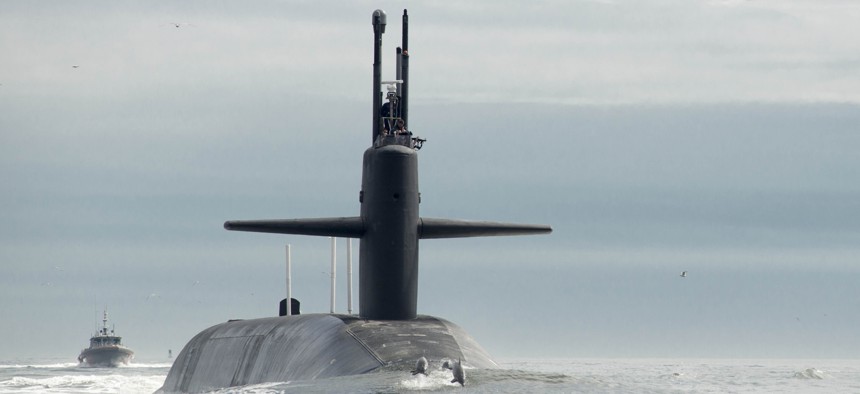
The Ohio-class ballistic missile submarine USS Tennessee (SSBN 734) returns to Naval Submarine Base Kings Bay, Tennessee, deployed for operations more than three months earlier. U.S. Navy/Mass Communication Specialist 1st Class James Kimber
Nuclear vs. Conventional Spending? We Don’t Have that Luxury
The call to boost one at the expense of the other is wrong.
Voltaire reportedly once remarked “Lord, protect me from my friends; I can take care of my enemies.” This thought immediately came to mind as we read a recent commentary in Defense One recommending dramatic increases to America’s military stocks for the next five years, and the cost of its nuclear weapons.
In “Four Lessons Should Upend Pentagon’s Five-Year Strategy,” John Ferrari, now a visiting fellow at the American Enterprise Institute, raises concerns about a deficit in War Reserve Munitions. His thinking about a possible war in this decade and the effects of inflation on the defense budget are spot-on. We would be the first to agree that that Defense Department topline needs something like 5 percent real annual growth to keep pace with the unprecedented national security challenges facing the nation.
But the call to increase defense spending for conventional capabilities at the expense of modernizing our nuclear forces could not be more wrong. Spending increases for both are necessary.
Ferrari falls into the familiar trap, carefully prepared by the progressive anti-U.S. nuclear forces movement, by quoting a notional “nearly trillion-dollar” cost to modernize the nuclear triad. That frequently cited figure involves notorious double counting of dual-use systems and ignores that fact that the cost of nuclear modernization will be amortized over a 30-year life cycle. Moreover, at a time when Congress has appropriated nearly $6 trillion in two years for domestic needs in the wake of the COVID pandemic, spending $1 trillion over three decades on a national security insurance policy that has served the nation well for 75 years seems like a bargain at twice the price.
Second, three ongoing threats should serve to remind all of us that nuclear weapons continue to play a crucial role in world affairs: Russia’s brandishing of its nuclear weapons and explicit threats about possible nuclear weapons use in the Ukrainian war; Kim Jong-un’s similar tactics of missile tests and nuclear scare-mongering; and China’s continued expansion of its nuclear forces, which U.S. Strategic Commander Adm. Charles Richard called “breathtaking.” Failing to modernize our triad of nuclear delivery systems, which are already suffering from a two-decade procurement holiday, would be tantamount to condemning those systems to retirement without replacement.
If you think the world is dangerous now, try envisioning it without a credible, safe and reliable nuclear deterrent.
Third, general arm-waving about cutting nuclear modernization costs begs the following questions: what is it specifically that opponents propose cutting? Should we abandon the new Sentinel intercontinental ballistic missile in favor of keeping the 70-year-old Minuteman III? Do we buy fewer B-21 stealth bombers, which also have a conventional mission, just as they begin to enter full-scale production? Should we halt the assembly line that is building replacement SSBNs even as the existing Ohio-class boats will be forced to retire in the years ahead on safety grounds? Any of these would delay critical replacements for aging platforms in the field today as well as drive up overall program costs as procurement is stretched out and delayed.
Fourth, the notion that the White House’s Office of Management and Budget will provide separate line-items to fund triad modernization outside the defense budget is risible. Whether such special funds should exist, as they do in the UK to support Britain’s continuous at sea deterrent is an interesting philosophical question but not one that will help us negotiate the immediate challenges facing the United States’ defense establishment today.
Fifth, a clear-eyed look at the true cost of nuclear modernization will reveal that it constitutes between 2.5 and 3.0 percent of the defense budget. The operation and sustainment of the existing force accounts for another 3.5 to 4.0 percent. Simple arithmetic makes clear, therefore, that the percentage of the Defense Department budget not devoted to nuclear systems is about 93 percent. Looking to save money on the nation’s nuclear forces remains the “hunt for small potatoes” as David Mosher, the former director of the national security division of the Congressional Budget Office, described it some 20 years ago. It is no doubt for that reason that former Defense Secretary Jim Mattis said that the cost of nuclear modernization is a small price to pay to deter an existential threat.
Finally, Ferrari’s thesis ignores the fundamental truth that an effective nuclear force deters not only nuclear attack but also conventional aggression against our treaty allies in NATO and the Pacific. Would Putin have attacked Ukraine if Kyiv had retained a nuclear arsenal? Would he be striking NATO if our nuclear umbrella, aged as it is, was not in place? Would we and other NATO members be able to resupply Ukraine without a strong nuclear deterrent? These questions answer themselves.
Now more than ever we should be clear that our nuclear deterrent plays many roles, and in the first instance deterring a major non-nuclear strategic attack is vital.
Eric S. Edelman is counselor at the Center for Strategic and Budgetary Assessments. He served as defense undersecretary for policy from 2005 to 2009. Franklin Miller is a principal of the Scowcroft Group and chairman emeritus of the Charles Stark Draper Laboratory. Both have held senior positions in national security affairs over administrations of both parties.




